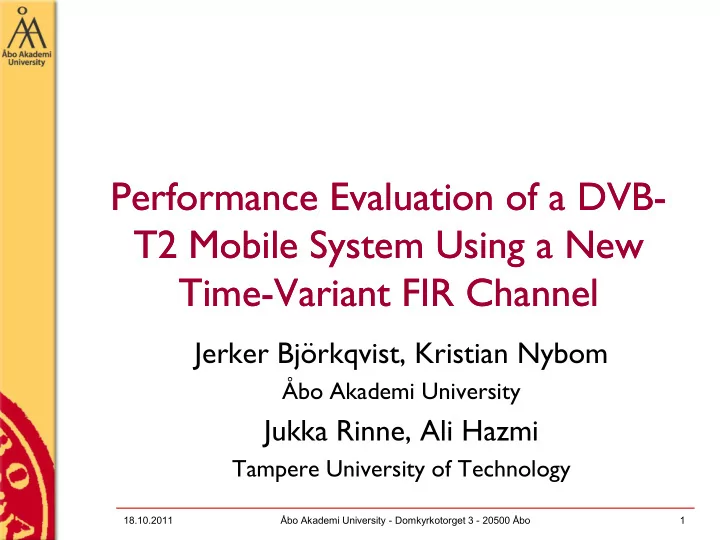

Performance Evaluation of a DVB Performance Evaluation of a DVB- T2 Mobile System Using a T2 Mobile System Using a New New Time Time-Variant Variant FIR Channel FIR Channel Jerker Björkqvist, Kristian Nybom Åbo Akademi University Jukka Rinne, Ali Hazmi Tampere University of Technology 18.10.2011 Åbo Akademi University - Domkyrkotorget 3 - 20500 Åbo 1
Presentation Outline Presentation Outline Introduction Motivation Time-Variant FIR Channel Model Simulations – Setup – Results Conclusions 18.10.2011 Åbo Akademi University - Domkyrkotorget 3 - 20500 Åbo 2
Introduction Introduction A FIR channel model for performance evaluation of mobile reception Based on the DVB-T2 Helsinki channel sounding in 2010 Channel model is based on FIR filtering of the measured data Mimics the channel conditions experienced during the channel sounding 18.10.2011 Åbo Akademi University - Domkyrkotorget 3 - 20500 Åbo 3
Motivation Motivation Common channel models are fixed representations of a multipath channel model For mobile reception, analysis in a time varying scenario is important Using the time variant FIR channel model presented here gives the possibility to – Analyze mobile performance – Analyze different system settings – Analyze the effect of adding additional interleaving depth by additional coding 18.10.2011 Åbo Akademi University - Domkyrkotorget 3 - 20500 Åbo 4
Time Time-Variant FIR Channel Model Variant FIR Channel Model A discrete multipath channel can be described as whereas the general format for a FIR filter is and with Gaussian noise At each time sample instant k , a new FIR filter h k will be used With small filter kernel lengths ( N <20), the simulation speed is increased 18.10.2011 Åbo Akademi University - Domkyrkotorget 3 - 20500 Åbo 5
Time Time-Variant FIR Channel Model Variant FIR Channel Model A data analysis of the measured data in Helsinki revealed that 8 multipath taps describe sufficiently the time-variant multipath behaviour of the channel Power delay profile 18.10.2011 Åbo Akademi University - Domkyrkotorget 3 - 20500 Åbo 6
Time Time-Variant FIR Channel Model Variant FIR Channel Model Tap-wise Doppler spectra applied where is the classical Jakes Doppler spectrum 40 Hz Doppler when the frequency is 800 MHz 18.10.2011 Åbo Akademi University - Domkyrkotorget 3 - 20500 Åbo 7
Time Time-Variant FIR Channel Model Variant FIR Channel Model 18.10.2011 Åbo Akademi University - Domkyrkotorget 3 - 20500 Åbo 8
Simulation Setup Simulation Setup A single PLP with: – 64800 bits FEC, rate ½ – All supported QAM modulations – Maximum time interleaving – FFT size 8k – Guard interval 1/8 Stopping criterion for simulations: – 20 erroneous FEC frames had been accumulated or – 2000 FEC frames had been decoded without errors 18.10.2011 Åbo Akademi University - Domkyrkotorget 3 - 20500 Åbo 9
T2 Performance on the FIR channel model T2 Performance on the FIR channel model 1,00E+00 1,00E-01 1,00E-02 FIR QPSK BER FIR 16QAM FIR 64QAM 1,00E-03 FIR 256QAM 1,00E-04 1,00E-05 0 2 4 6 8 10 12 14 16 18 20 SNR (dB) Small error floors visible in the middle of the waterfall regions 18.10.2011 Åbo Akademi University - Domkyrkotorget 3 - 20500 Åbo 10
FIR vs F1 FIR vs F1 1,00E+00 1,00E-01 FIR QPSK 1,00E-02 FIR 16QAM FIR 64QAM BER FIR 256QAM F1 QPSK 1,00E-03 F1 16QAM F1 64QAM F1 256QAM 1,00E-04 1,00E-05 0 2 4 6 8 10 12 14 16 18 20 SNR (dB) 18.10.2011 Åbo Akademi University - Domkyrkotorget 3 - 20500 Åbo 11
FIR vs P1 FIR vs P1 1,00E+00 1,00E-01 FIR QPSK 1,00E-02 FIR 16QAM FIR 64QAM BER FIR 256QAM P1 QPSK 1,00E-03 P1 16QAM P1 64QAM P1 256QAM 1,00E-04 1,00E-05 0 2 4 6 8 10 12 14 16 18 20 SNR (dB) 18.10.2011 Åbo Akademi University - Domkyrkotorget 3 - 20500 Åbo 12
QPSK @ SNR 4 dB QPSK @ SNR 4 dB 1,00E+00 BER in FEC block Moving Average BER 1,00E-01 1,00E-02 BER 1,00E-03 1,00E-04 1,00E-05 1,00E-06 0 5000 10000 15000 20000 25000 30000 35000 FEC Block Index The 1000-point moving average shows time variance 18.10.2011 Åbo Akademi University - Domkyrkotorget 3 - 20500 Åbo 13
Conclusions Conclusions The time variant FIR channel model shows worse performance than those obtained from static channel models – The FIR channel results in varying FEC block error ratios for any given SNR The gain of the strongest tap was normalized – Future work includes using varying gains for all taps – Will give more information on how the time interleaving in DVB-T2 works in mobile scenarios – Future studies also includes analysis of the MIMO case 18.10.2011 Åbo Akademi University - Domkyrkotorget 3 - 20500 Åbo 14
Recommend
More recommend